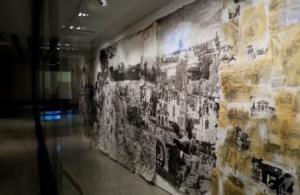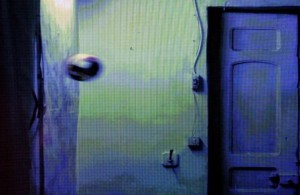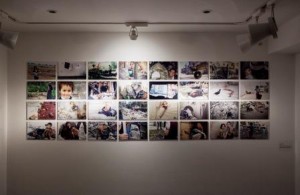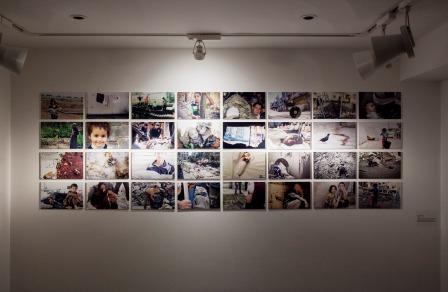A Free and Open Space: P21 Gallery & #Withoutwords
By Ruba Asfahani
This article was first published on www.muftah.org and has been reproduced here with their permission.
The independent non-profit organization P21 Gallery is based in a busy central location in London near the British Library and the Wellcome Collection. Established to promote contemporary Middle Eastern art and culture, the stunning ultramodern building was designed by the award-winning Egyptian architect Professor Abdul Halim Ibrahim, and is decked out with marble shipped in from Jerusalem.
The incredible facilities provided by P21 are exactly what Middle Eastern art in London needs. They feature a beautiful expansive gallery space over two floors, a central café, a stacked library, and a superb cinema which doubles as a lecture hall.
It is a shame that more people do not know about P21, but I am sure that is all about to change.
 The Leaders
The Leaders
I sat down with gallery director, Yahya Zaloom, and assistant director, Inzajeano Latif, to find out more about P21 and what they are hoping to achieve with this space.
The overarching message of P21 is one of communication and understanding. The gallery has an open door policy for artists and curators who can use the space and share their views and work.
As artists themselves, the staff do their utmost to give advice and find avenues for their creative visitors to showcase their work.
Middle Eastern art has a tendency to focus on politics and religion, but P21 is hoping to showcase a new voice and to produce a new kind of artistic dialogue between the Middle East and the West.
As Zaloom states, “here you can say whatever you like, there shouldn’t be any restrictions through art and culture. At the moment, there are not that many opportunities for the younger generations, no strong platforms for curators or artists.”
For the P21 team, it is vital that there are no egos or maniacal dependencies on money-making. Rather, the attention is on the mission: to introduce new artistic discourses to Western audiences.
As Latif knows all too well, it is tough to enter the Western contemporary art scene, “hierarchies and ethnic minorities have effects on what you end up doing as an artist. P21 doesn’t conform to old standards of many institutions. We are a free and open space.”
The Inaugural Show
As a platform for experimental art, P21 has hosted an exhibition entitled Refraction: Moving Images On Palestine, curated by Shaheen Merali.
In this show, thirteen artists examine issues of balance, fairness, perspectives, proportionality, and the use of power. All the works exhibited shock the audience into silence.
For me, the strongest work was Palestine (2008) by the duo kennardphillipps. This impressive piece represents a variety of critical moments in Palestine’s history. Exhausting multiple understandings of a complicated state, the people described, places disclosed, and moments captured were utilized in a mural well equipped to re-educate those who pigeon-hole “Palestinian” art.
#withoutwords
 The Refraction exhibition was just the beginning for P21.
The Refraction exhibition was just the beginning for P21.
Looking to elevate ideas and in Latif’s words, to “show work the Western audience isn’t used to,” #withoutwords brings a new dimension to Middle Eastern art, this time with the focus on Syria’s forgotten artists.
With limited exposure to the international art scene, Syrian artists have been somewhat side-lined. That is all set to change with the ongoing civil unrest, much like the Egyptian art scene after February 2011.
The exhibition is presented in partnership with Mosaic Syria, a non-profit NGO with a similar mission to P21. Based in London, Mosaic Syria dedicates itself to its attempts at improving the lives of Syrians caught in the country’s humanitarian disaster, by sending convoys to the country, delivering medical supplies and general humanitarian aid.
#withoutwords presents the British public with an unadulterated view of events in Syria. By combining emerging artists with more well-known figures, the curatorial team is hoping to achieve a measure of balance amid powerful imagery and artistic discourse.
Speaking to Malu Halasa and Fadi Haddad, members of the curatorial team, I was keen to find out how they thought the visitors would react to some of the more dogmatic works such as the political cartoons by the well-known Ali Ferzat, an explicit series of photographs by the Lens Young collective, and a haunting painting by Tarek Tuma, amongst others.
Both agreed that this exhibition should be seen as a documentary covering current events in Syria. “We are creating a space for communication; we are not trying to make political changes or statements through the art work,” stated Haddad. “In #withoutwords, we have no filter; we just want to show the real truth of what these artists live through. And when you live in a dictatorship, you have a lot of time on your hands. This is what the exhibition represents,” added Halasa.
 It was encouraging to see such a wide range of media presented in the exhibition as well as a variety of styles, techniques and messages. As is often the case, the most talked about works are those that are politically charged.
It was encouraging to see such a wide range of media presented in the exhibition as well as a variety of styles, techniques and messages. As is often the case, the most talked about works are those that are politically charged.
Having read comments from The Guardian’s review of the exhibition, I was curious to ask the curatorial team how they felt about someone dubbing Tarek Tuma’s painting “propaganda.”
The painting is of Hamza Bakkour, a thirteen year old boy whose jaw was blown off during an attack by pro-Assad forces during the siege of Baba Amr last year.
The large scale painting is not only overtly graphic, hung using large imposing nails that directly pierce through the canvas into the wall. It also takes centre stage in the exhibition, making it completely unavoidable as visitors walk into the main body of the gallery.
Haddad could only answer my question with a question, “Why is this propaganda? Bakkour is an emblematic character, one that everyone in Syria knows. He is a martyr and a representation of what is going on in Syria. This is not propaganda. This is art.”
It is easy to see why those unfamiliar with the Arab art world would consider some of the works in #withoutwords propaganda. It is interesting to think that at a time when most galleries are trying to avoid such overtly political works, P21 and Mosaic Syria have not shied away from controversial subjects and have curated a combination of expressive works alongside more approachable pieces such as Ronak Ahmed’s sculptures.
The difficulty I found in #withoutwords is that the more pacified artworks are overshadowed by the large scale candid video works, photography, and paintings focusing on the war in Syria.
The curatorial team has tried to find an appropriate balance, but it is obvious to most that the pieces from Syria are not ones that can just be ignored, even when there are other works on exhibit in the show.
One such piece was a small room dedicated to Lens Young’s photographic works. A cautionary ‘warning’ sign was stuck to the door, advising visitors that the images inside were of a sensitive nature.
Upon walking into a small room, the visitor is met by four rows of explicit images of war-torn Syria. Photographs of dead children, rubble from destroyed buildings, and the day-to-day destructive impact of war are forced upon viewers as they enter.
Asking Latif, about this particular set-up, I could not help but question why such harsh imagery used predominantly in Arab media was brought to the London gallery.
“In this particular installation we take photojournalist imagery out of its acceptable context,” says Latif. “The approach to this work is not to impose but to reveal, so if someone was to think that these have a somehow forced and overly imposed narrative then so be it. The best works always leave space for the viewer to impose their own views and opinions on what and how they view works in a gallery. It’s about the bigger picture that in the West is fed to us tamely, allowing us to sit comfortably in our bubble and make judgements on places we only know through the distortion of media.”
This particular room not only brings up the repeated question of propaganda, but also the age-old argument about what separates photojournalism and art. If one chooses to display a photograph of a recently slaughtered toddler but curate it with other images and sound, does that automatically make it a work of art? This is a subject suited to its own doctoral thesis, but most visitors will not last longer than a few minutes in this room. And the images are haunting. But maybe that’s what we, the visitors, need: a wakeup call?
The stories of the artists themselves, as well as the various challenges involved in getting the artwork to London alone, are enough to highlight the complex situation inside Syria. Most of the pieces for this show had to be smuggled out of Syria, either through neighbouring Lebanon or Turkey, or by choosing artists that had already escaped their native country. Some artists have even gone unnamed in this exhibition for fear of potential repercussions.
Failing to visit this exhibition (which comes to a close on September 1st) would be a tragedy, regardless of one’s particular views on Syria’s political instability. Khaled Abdulwahed’s two videos: Bullet and Tuj will, for example, resonate with the viewer for days. In Tuj one is left alone at the foot of the ramp to the gallery to watch a football bouncing against a wall. No backdrop, no human interaction, just the ball and its noise as it thumps against a domestic interior. After some time, the repetitive and identifiable pounding turns into gunshot sounds, then the blasts of bombs, and then… go and see the video, I implore you. It’s worth all two minutes and fifteen seconds. Abdulwahed describes it as “a surrealistic scene, where the sounds of balls and bombs, life and death, intermingle.”
#withoutwords offers a distinctive and current narrative on Syria, a fresh look at a long ignored part of the Middle Eastern art world. The artists and curatorial team should be applauded for having the courage to embark on an exhibition such as this when most would try to avoid a subject “no one would touch with a barge-pole,” as one reader commented in a review of the exhibition by The Guardian.

